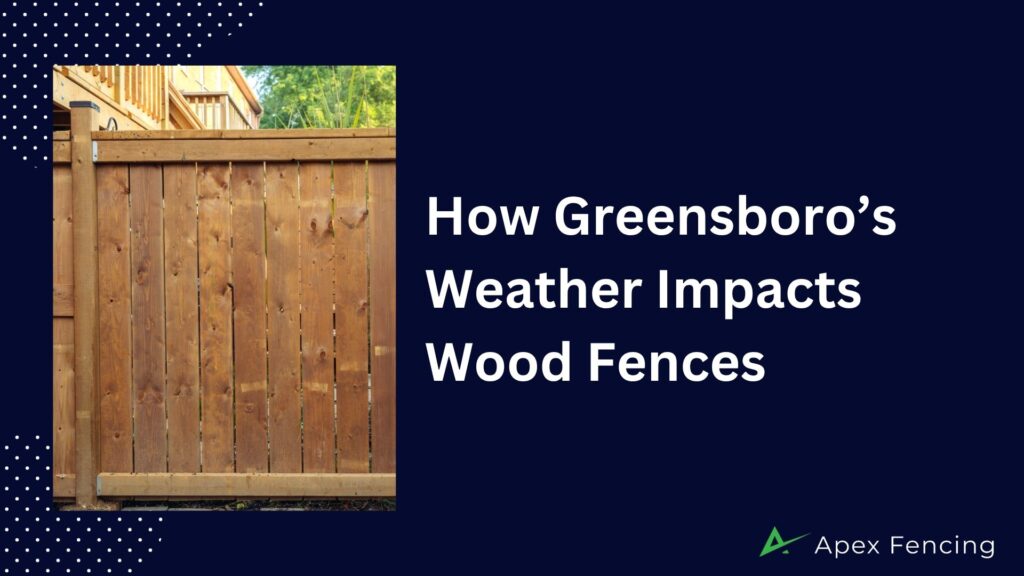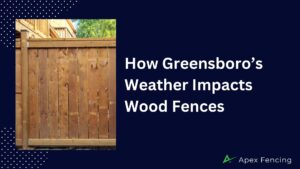Greensboro’s humid subtropical climate—hot, humid summers, mild but wet winters, and year-round rainfall—puts wood fences under constant stress. Moisture cycles, UV exposure, and occasional storms can speed up swelling, warping, rot, insect activity, and mildew in ways you won’t see in drier or colder regions. The good news: a few climate-smart choices and a consistent maintenance routine dramatically extend your fence’s life.
Key takeaways
- Climate pressure: Greensboro’s heat, humidity, and steady rain accelerate mildew, rot, warping, and fastener corrosion.
- What works here: Pressure-treated or rot-resistant wood, breathable UV-blocking stains, good drainage/ventilation, stainless or hot-dipped galvanized hardware, and regular cleaning/inspections.
- Act early: Small fixes cost less than structural repairs. For professional wood fence repair in Greensboro, Apex Fencing can help.
Why Climate Is Tough on Wood in Greensboro
Seasonal patterns
- Summer: High humidity (often 70%+), frequent thunderstorms → boards swell, cup, and pop fasteners; mildew spreads in shaded areas.
- Winter: Mild but wet with occasional freezes → slow drying times, freeze-thaw stress at post bases.
- Year-round rain (≈45″ annually): Soil stays damp; splash-back and pooling speed decay at the base of posts and lower boards.
Local geography
Greensboro’s clay-rich soils drain slowly. Low-lying or shaded yards hold moisture longer, so posts rot sooner and rails loosen faster. On slopes, panels dry unevenly and warp.
How Weather Damages Wood Fences
| Weather Factor | What Happens | What You’ll See |
|---|---|---|
| High humidity & rain | Wood absorbs water → swelling, fungal growth | Cupped/raised boards, soft spots near ground, mildew/green staining |
| UV/summer heat | Lignin breakdown → drying, checking | Fading, surface cracking, splinters (esp. south/west faces) |
| Temperature swings | Expansion/contraction → joint failure | Loose nails/screws, gaps, misaligned gates |
| Storms & wind | Uplift/lateral loads on panels | Leaning sections, snapped rotten posts, loose rails |
Protection That Works in Greensboro
Materials & hardware
- Use pressure-treated pine or naturally rot-resistant cedar/cypress.
- Choose stainless or hot-dipped galvanized fasteners and hinges.
- Set posts 30–36″ deep on 4–6″ gravel, then concrete collars sloped for runoff.
Finishes & schedule
- Apply a penetrating, water-repellent stain with UV inhibitors; recoat every 2–3 years (semi-transparent) or 4–6 years (solid).
- Seal end grain (cuts, post tops) and focus on south/west faces that weather fastest.
Drainage & ventilation
- Maintain 1–2″ clearance between soil and bottom boards; raise bottom rails 2–4″ off grade.
- Add a 2–4″ gravel strip along the fence to reduce splash-back.
- Keep 6–12″ vegetation clearance for airflow; redirect sprinklers away from wood.
Inspection & cleaning
- Inspect twice a year (spring/fall) and after big storms.
- Soft-wash annually (low pressure) and spot-treat mildew with oxygen bleach; allow 48–72 hours of dry weather before staining.
Quick Reference Tables
Humidity & Temperature: Causes and Effects
| Condition | Effect on Wood |
|---|---|
| High summer humidity | Swelling, mildew, faster rot |
| Big day/night temp swings | Cracks, split rails, loose fasteners |
| Mild, wet winters | Prolonged dampness → decay risk |
Protection Strategies vs. Results
| Strategy | Benefit |
|---|---|
| Pressure-treated/rot-resistant wood | Longer service life in humidity |
| Penetrating stain (2–3 yr cycle) | Less moisture uptake & UV damage |
| 1–2″ ground clearance + airflow | Faster drying, less rot |
| Stainless/HDG fasteners | No rust stains; tighter connections |
Seasonal Care Checklist (Greensboro)
- Spring: Wash off mildew, tighten hardware, spot-sand, inspect posts/rails.
- Summer: Monitor for cupping, nail pops, and insect activity; maintain airflow.
- Fall: Clear leaves/debris, confirm drainage, re-seal while temps allow.
- Winter: Check post plumb after storms; address freeze-thaw heave early.
Quick Tip: Apply a weather-resistant, UV-blocking stain every 2–3 years and always seal freshly cut ends to stop wicking.
Repair vs. Replacement—How to Decide
Repair when damage is limited to a few pickets, rails, or surface cracks. Tighten/replace hardware and re-seal; this can add 2–5 years of life.
Replace when you have multiple rotten posts, panels leaning >2–3″, or 30–50% of boards compromised. Posts failing at/below grade are the biggest red flag.
Common Mistakes to Avoid
- Skipping inspections: Small issues become structural repairs.
- Using film-forming paints/cheap sealers: They trap moisture in humid climates.
- Ignoring drainage: Soil touching boards or ponding at posts accelerates rot.
- Over-pressure washing: It shreds fibers and invites water intrusion.
DIY Mini-Guides
- Minor cracks: Fill with exterior wood epoxy, sand, then re-stain.
- Leaning section: Reset the post (24–30″ deep) on gravel with concrete collar; add temporary bracing while curing.
- Color restore: Clean, dry 48–72 hrs, then apply a semi-transparent, UV-blocking stain; back-brush into end grain.
The Bottom Line
Greensboro’s climate will test any wood fence—but with the right materials, drainage, finishes, and a simple maintenance rhythm, you’ll keep yours straight, solid, and good-looking for years. If you’d prefer a professional fence contractor—or need targeted repairs—Apex Fencing can help with inspection, repair, and climate-smart protection plans tailored to Greensboro homes.







